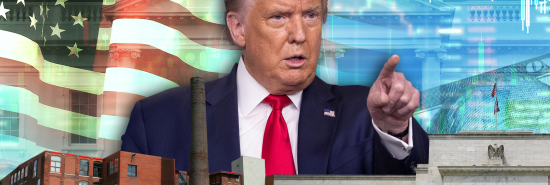
Here’s what Trump’s economic agenda will look like if he’s back in the White House
Tiana Lowe Doescher
Video Embed
If former President Donald Trump claws his way back to the White House, he’ll face unfinished business from his signature domestic achievement as president.
Expiring provisions of the 2017 Tax Cuts and Jobs Act will confront either a restored Trump, a reelected President Joe Biden, or another 2024 presidential winner. Taxes are set to go up on broad swaths of the economy in 2025 if something isn’t done since Trump and a then-Republican Congress enacted the law through Senate budget rules requiring only a bare majority to pass the chamber rather than the usual 60-vote filibuster hurdle, which limits the duration of some tax cuts.
UP FOR DEBATE: TRUMP, DESANTIS, AND 2024 GOP HOPEFULS’ STANCE ON AI
Revisiting the TCJA would be just one component of Trump’s economic agenda in a second term, which isn’t a fanciful notion, even though he faces 91 criminal counts across four separate criminal cases. Trump is the undisputed Republican presidential primary front-runner. And though Biden benefits from the favorable political headwinds of his incumbency, the real roadblock threatening the president’s reelection is not his son Hunter Biden or even his record-setting status as the first octogenarian to occupy the Oval. Rather, Biden’s biggest liability is the economy and, more specifically, the 16% increase in overall prices since he took office.
Trump would have to reckon with the expiration of most of the TCJA’s individual income tax provisions in the second half of 2025. While Trump would surely move to extend his signature legislative achievement, which would cost $3.3 trillion through 2033, he will reckon with an economy fundamentally transformed since the law’s enactment in December 2017.
The COVID-19 spending boondoggle by both Congress and the Federal Reserve resulted in about 2 million boomers cashing in on artificially inflated asset bubbles, and retiring early, expediting the crisis of our aging society’s shrinking workforce. This problem compounds the impending insolvency of Social Security by 2033, as the ratio of workers to Social Security recipients decreased from its already record low point of 3-1 to 2-1. Trump has distinguished himself as the loudest Republican refusing to reform Social Security, which, if nothing is done, means a 23% across-the-board benefit cut within a decade. The Committee for a Responsible Federal Budget found this translates to a $17,400 benefit cut for a typical newly retired dual-income couple.
Federal Reserve Clashes
A second, nonconsecutive Trump term would likely mean renewed clashes with the Federal Reserve. Trump previously showed no more respect for the precedent of an independent Central Bank than he did for the judgment and discretion of voters in Arizona, Georgia, Michigan, and elsewhere when he engaged false claims about the logistics of the 2020 election in a futile effort to reverse his loss to Biden.
In 2018 and 2019, Federal Reserve Chairman Jerome Powell showed admirable resolve in ignoring taunts and insults from Trump, the president who had appointed him, over interest-rate policy. Trump repeatedly attacked Powell for raising rates from near zero despite the persistence of the longest bull market run in history.
Trump has since shifted his tone, now jabbing Powell for his dovish approach to the start of the worst inflation crisis in 40 years. During an interview with Fox Business’s Larry Kudlow, director of the National Economic Council in his administration, Trump noted that Powell was “always late, whether it was good or bad.”
While Trump has shown zero interest in reforming the Fed’s dual mandate, which has the central bank balance the two goals of maximizing employment and stabilizing inflation at no more than 2% on an annual basis, he has strayed from his heterodox monetary inclinations. That includes recently expressing worry about the dollar’s diminishing share of global currency reserve and the yuan’s threat to the greenback’s dominance, a tenant of long-running China criticisms.
If in position as president again to replace Powell as Fed chairman or fill other positions, Trump would likely consider Kudlow or economist Judy Shelton. Both are widely respected and mainstream conservative-leaning economists. Though Trump’s 2019 nomination of Shelton to the Fed Board stalled in the Senate for more than a year and Biden withdrew it after taking office.
Green Be Gone
Trump likely would aim to overturn much of his predecessor’s industrial policy. That includes gutting the Biden administration’s green energy tax breaks and subsidies as a part of a commitment to unleashing domestic energy production. Trump also could dramatically expand his tariff regime. That would mean proposing universal, baseline tariffs on the vast majority of foreign imports. This consumption tax revenue would then fund domestic tax cuts, including making permanent corporate tax cuts in the TCJA while streamlining and simplifying other parts of the federal tax code.
Trump has made clear he wants to cut some nonentitlement spending, promising to upend the Impoundment Control Act, a Nixon-era restriction on presidents’ ability to delay or cancel congressionally appropriated funding significantly.
CLICK HERE TO READ MORE FROM THE WASHINGTON EXAMINER
“Reasserting the president’s historic Impoundment authority will also restore critical negotiating leverage with Congress to keep spending under control,” Trump said in June. He further pledged to withhold funds “to obliterate the deep state, drain the swamp, and starve the warmongers … and the globalists out of government.”
Ultimately, Trump will continue to combine his gut instinct for protectionism to put “America First” with his priority of economic growth over conventionally conservative spending cuts. While piecemeal defunding of the federal bureaucracy will slow our projected growth of spending, Trump’s real bet is similar to that which he made for returning to office on Jan. 20, 2025: that we can grow our way out of projected spending increases through pro-business and protectionist policy.
